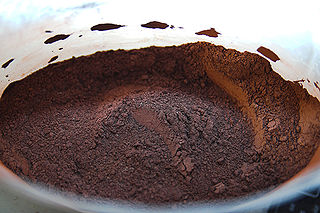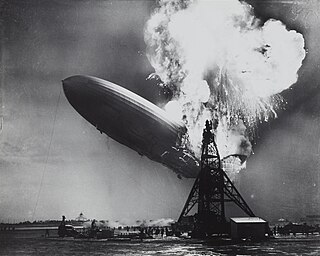Related Research Articles

Thermite is a pyrotechnic composition of metal powder and metal oxide. When ignited by heat or chemical reaction, thermite undergoes an exothermic reduction-oxidation (redox) reaction. Most varieties are not explosive, but can create brief bursts of heat and high temperature in a small area. Its form of action is similar to that of other fuel-oxidizer mixtures, such as black powder.

LZ 129 Hindenburg was a German commercial passenger-carrying rigid airship, the lead ship of its class, the longest class of flying machine and the largest airship by envelope volume. It was designed and built by the Zeppelin Company on the shores of Lake Constance in Friedrichshafen, Germany, and was operated by the German Zeppelin Airline Company. It was named after Field Marshal Paul von Hindenburg, who was President of Germany from 1925 until his death in 1934.

Liquid hydrogen (H2(l)) is the liquid state of the element hydrogen. Hydrogen is found naturally in the molecular H2 form.

A hypergolic propellant is a rocket propellant combination used in a rocket engine, whose components spontaneously ignite when they come into contact with each other.

Static electricity is an imbalance of electric charges within or on the surface of a material. The charge remains until it can move away by an electric current or electrical discharge. The word "static" is used to differentiate it from current electricity, where an electric charge flows through an electrical conductor.

Incendiary weapons, incendiary devices, incendiary munitions, or incendiary bombs are weapons designed to start fires. They may destroy structures or sensitive equipment using fire, and sometimes operate as anti-personnel weaponry. Incendiaries utilize materials such as napalm, thermite, magnesium powder, chlorine trifluoride, or white phosphorus. Though colloquially often called "bombs", they are not explosives but in fact operate to slow the process of chemical reactions and use ignition rather than detonation to start or maintain the reaction. Napalm, for example, is petroleum especially thickened with certain chemicals into a gel to slow, but not stop, combustion, releasing energy over a longer time than an explosive device. In the case of napalm, the gel adheres to surfaces and resists suppression.

A liquid-propellant rocket or liquid rocket uses a rocket engine burning liquid propellants. (Alternate approaches use gaseous or solid propellants.) Liquids are desirable propellants because they have reasonably high density and their combustion products have high specific impulse (Isp). This allows the volume of the propellant tanks to be relatively low.

The J-2, commonly known as Rocketdyne J-2, was a liquid-fuel cryogenic rocket engine used on NASA's Saturn IB and Saturn V launch vehicles. Built in the United States by Rocketdyne, the J-2 burned cryogenic liquid hydrogen (LH2) and liquid oxygen (LOX) propellants, with each engine producing 1,033.1 kN (232,250 lbf) of thrust in vacuum. The engine's preliminary design dates back to recommendations of the 1959 Silverstein Committee. Rocketdyne won approval to develop the J-2 in June 1960 and the first flight, AS-201, occurred on 26 February 1966. The J-2 underwent several minor upgrades over its operational history to improve the engine's performance, with two major upgrade programs, the de Laval nozzle-type J-2S and aerospike-type J-2T, which were cancelled after the conclusion of the Apollo program.
The highest specific impulse chemical rockets use liquid propellants. They can consist of a single chemical or a mix of two chemicals, called bipropellants. Bipropellants can further be divided into two categories; hypergolic propellants, which ignite when the fuel and oxidizer make contact, and non-hypergolic propellants which require an ignition source.
A flash fire is a sudden, intense fire caused by ignition of a mixture of air and a dispersed flammable substance such as a solid, flammable or combustible liquid, or a flammable gas. It is characterized by high temperature, short duration, and a rapidly moving flame front.

The Hindenburg disaster was an airship accident that occurred on May 6, 1937, in Manchester Township, New Jersey, United States. The LZ 129 Hindenburg was a German commercial passenger-carrying rigid airship, the lead ship of the Hindenburg class, the longest class of flying machine and the largest airship by envelope volume. It was designed and built by the Zeppelin Company and operated by the German Zeppelin Airline Company. It was named after Generalfeldmarschall Paul von Hindenburg, who was president of Germany from 1925 until his death in 1934. Filled with hydrogen, it caught fire and was destroyed during its attempt to dock with its mooring mast at Naval Air Station Lakehurst. The accident caused 35 fatalities among the 97 people on board, and an additional fatality on the ground.

Aircraft dope is a plasticised lacquer that is applied to fabric-covered aircraft. It tightens and stiffens fabric stretched over airframes, which renders them airtight and weatherproof, increasing their durability and lifespan. The technique has been commonly applied to both full-size and flying models of aircraft.

In fire protection, an accelerant is any substance or mixture that accelerates or speeds the development and escalation of fire. Accelerants are often used to commit arson, and some accelerants may cause an explosion. Some fire investigators use the term "accelerant" to mean any substance that initiates and promotes a fire without implying intent or malice. The accelerant works by burning rapidly. As such, the accelerant itself is consumed in the process, and should not be considered as a catalyst. In Arson investigation, the significance of accelerant is to detect the presence of a such substance in order to proved that the fire is classified as an arson.

Incendiary ammunition is a type of ammunition that contains a chemical that, upon hitting a hard obstacle, has the characteristic of causing fire/setting flammable materials in the vicinity of the impact on fire.

Hydrogen safety covers the safe production, handling and use of hydrogen, particularly hydrogen gas fuel and liquid hydrogen. Hydrogen possesses the NFPA 704's highest rating of four on the flammability scale because it is flammable when mixed even in small amounts with ordinary air. Ignition can occur at a volumetric ratio of hydrogen to air as low as 4% due to the oxygen in the air and the simplicity and chemical properties of the reaction. However, hydrogen has no rating for innate hazard for reactivity or toxicity. The storage and use of hydrogen poses unique challenges due to its ease of leaking as a gaseous fuel, low-energy ignition, wide range of combustible fuel-air mixtures, buoyancy, and its ability to embrittle metals that must be accounted for to ensure safe operation.
The Hindenburg disaster has featured in a variety of popular culture films, TV programs and books.
Oxygen compatibility is the issue of compatibility of materials for service in high concentrations of oxygen. It is a critical issue in space, aircraft, medical, underwater diving and industrial applications. Aspects include effects of increased oxygen concentration on the ignition and burning of materials and components exposed to these concentrations in service.

An internal combustion engine is a heat engine in which the combustion of a fuel occurs with an oxidizer in a combustion chamber that is an integral part of the working fluid flow circuit. In an internal combustion engine, the expansion of the high-temperature and high-pressure gases produced by combustion applies direct force to some component of the engine. The force is typically applied to pistons, turbine blades, a rotor, or a nozzle. This force moves the component over a distance. This process transforms chemical energy into kinetic energy which is used to propel, move or power whatever the engine is attached to.

Alexander J. Dessler was an American space scientist known for conceiving the term heliosphere and for founding the first Space Science Department in the United States.
Werner Gustav Doehner was a German-born Mexican and American electrical engineer and last living survivor of the Hindenburg disaster, when the German passenger-carrying rigid airship caught fire and was destroyed on May 6, 1937, during its attempt to dock with its mooring mast.
References
- ↑ PBS interview(Expert Interview) Archived March 25, 2014, at the Wayback Machine
- ↑ "The Station That bain Built". www.hydrogenassociation.org. Archived from the original on May 18, 2006. Retrieved April 9, 2023.
- 1 2 AJ Dessler (June 3, 2004). "The Hindenburg Hydrogen Fire: Fatal Flaws in the Addison Bain Incendiary-Paint Theory" (PDF). colorado.edu. Retrieved April 9, 2023.
- ↑ "Florida Solar Energy Center". www.fsec.ucf.edu. Retrieved April 9, 2023.
- ↑ Secrets of the Dead: "What Happened to the Hindenburg?" 60 min., PBS Home Video, 2000.
- "The hydrogen technology assessment, phase 1", 1991, NASA Technical Reports Server
- "An assessment of the government liquid hydrogen requirements for the 1995-2005 time frame including addendum, liquid hydrogen production and commercial demand in the United States",1990, NASA Technical Reports Server
- "An assessment of the government liquid hydrogen requirements for the 1995-2005 time frame",1990, MASA Technical Reports Server